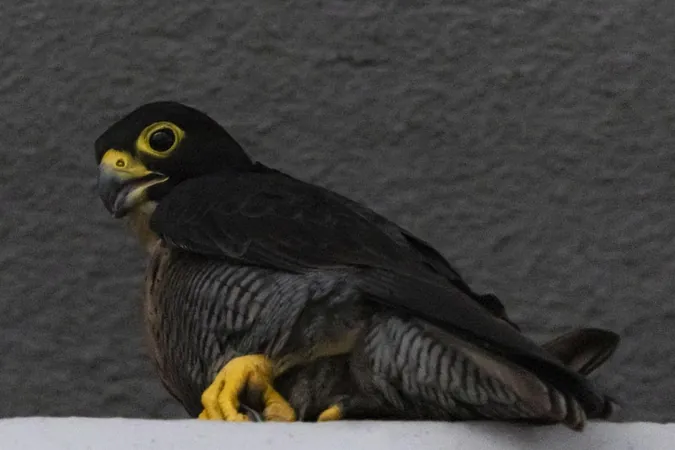
First Documented Peregrine Falcon Nesting in Downtown Singapore: A Unique Urban Wildlife Encounter
2024-11-23
Author: John Tan
Introduction
In a remarkable revelation, the urban landscape of Singapore has become the unlikely home for a pair of peregrine falcons, known to be the fastest animals on the planet, capable of reaching speeds exceeding 320 km/h in their hunting dive. This stunning event is taking place at the 34th floor of OCBC's premier private client centre on Chulia Street, where the falcons have made a cozy nest 10 meters above the balcony in a special recess.
Description of the Peregrine Falcon
The local subspecies, Falco peregrinus ernesti, which is distinguished by its solid black head, is slightly smaller than its northern migratory counterpart, Falco peregrinus calidus. The falcons are known for their lifelong mating habits, and the OCBC nesting site offers a safe and sheltered area that mimics their natural preference for limestone cliffs.
Documented Breeding Attempt
A biodiversity record released in August by researchers from the National Parks Board (NParks) has confirmed the first documented breeding attempt of these majestic birds in Singapore, with a pair of eggs discovered in the nest. Unfortunately, the eggs appear to have been abandoned, leading to the involvement of robotics researchers from the Singapore University of Technology and Design (SUTD) to retrieve these eggs safely.
The Retrieval Process
Initially, the plan was to deploy a drone for the retrieval, but the team pivoted to a more hands-on approach using a specially designed device named Ernest—an acronym for Egg Retrieval and Nesting Enhancement Support Tool. This innovative apparatus utilizes a telescopic pole and a claw, inspired by arcade claw machines, allowing for precise retrieval from the balcony recess.
Examination of the Eggs
Following their examination at the Lee Kong Chian Natural History Museum, one egg was found to have decomposed while the other, although intact, was determined to be likely non-fertile. Dr. Malcolm Soh, a principal researcher at NParks, suggested that the eggs might have been abandoned due to the shell damage.
Support for Future Breeding
In an effort to support future breeding, NParks has installed a nesting tray filled with loose gravel in the recess of the OCBC building. This will enable the falcons to create a more suitable nesting environment, as they can dig a small scrape for egg-laying. A CCTV camera system has also been put in place, enabling researchers to monitor the nesting progress throughout the breeding cycle, which typically occurs between late January and early February.
Urban Habitat Advantages
Interestingly, the urban environment has provided a surprisingly favorable setting for these birds. With the availability of pigeons in the central business district serving as a plentiful food source, the tall skyscrapers—specifically the OCBC Centre's protective overhang—offer a welcoming substitute for their traditional nesting ground.
OCBC's Contribution and Significance
OCBC has embraced this unexpected addition to their work environment, having contributed $10,000 towards the nesting and monitoring setup. Koh Ching Ching, OCBC's head of group brand and communications, expressed joy in witnessing this urban wildlife spectacle and its potential significance: “It is sometimes said that when a bird chooses to nest at your home, it can bring good luck to the owner.”
Conclusion
With only a small number of breeding pairs believed to exist in Singapore, this rare encounter stands as a testament to the city’s biodiversity and offers a chance for deeper understanding of the peregrine falcon's breeding behaviors in tropical climates. Researchers are hopeful that their data and observations will enhance knowledge of these incredible birds and guide future conservation efforts. Don't miss the chance to witness nature's marvel right in the heart of Singapore!


 Brasil (PT)
Brasil (PT)
 Canada (EN)
Canada (EN)
 Chile (ES)
Chile (ES)
 España (ES)
España (ES)
 France (FR)
France (FR)
 Hong Kong (EN)
Hong Kong (EN)
 Italia (IT)
Italia (IT)
 日本 (JA)
日本 (JA)
 Magyarország (HU)
Magyarország (HU)
 Norge (NO)
Norge (NO)
 Polska (PL)
Polska (PL)
 Schweiz (DE)
Schweiz (DE)
 Singapore (EN)
Singapore (EN)
 Sverige (SV)
Sverige (SV)
 Suomi (FI)
Suomi (FI)
 Türkiye (TR)
Türkiye (TR)